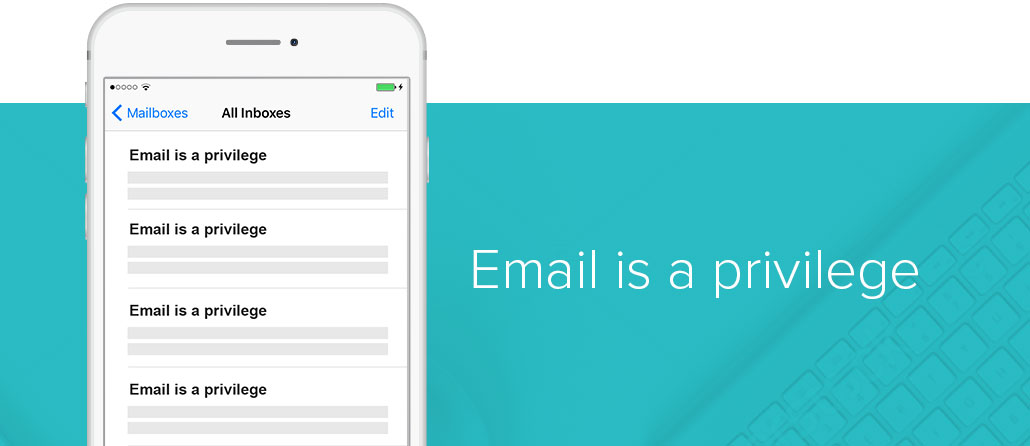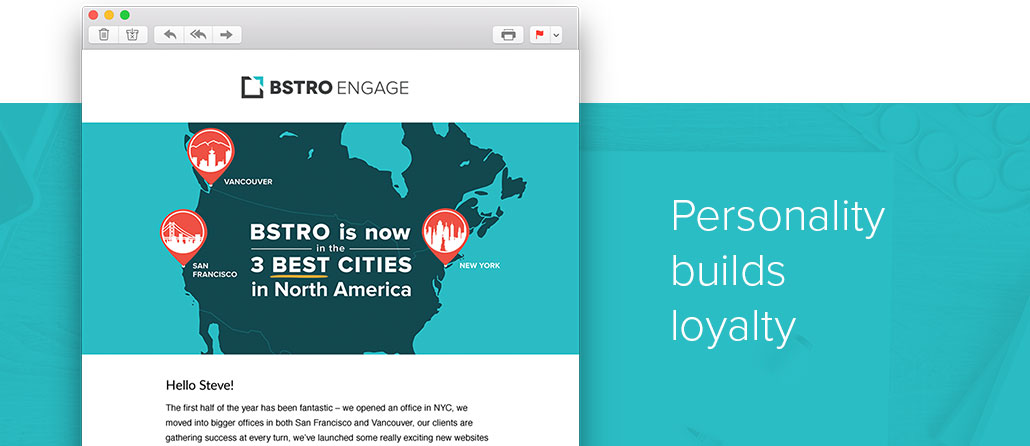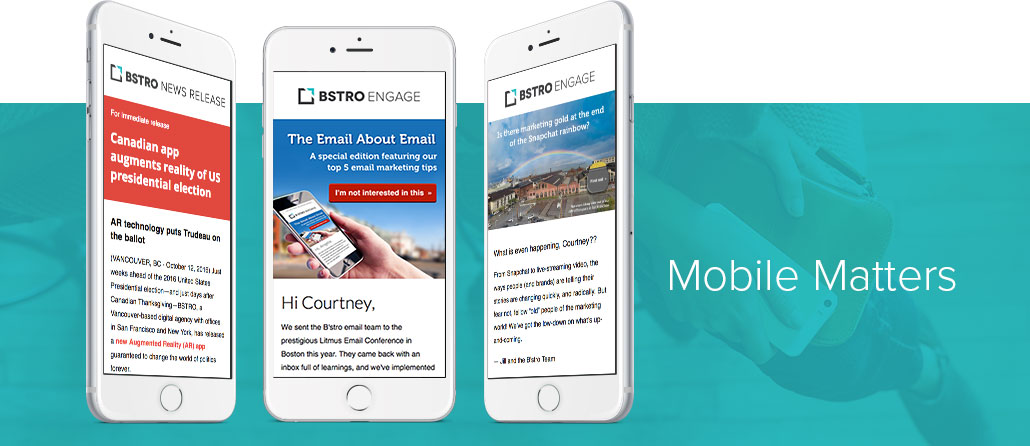The Art and Science of Email Marketing
December 12, 2016Here at BSTRO, we loooove email marketing. We geek out over all the details, from A/B testing to modular design to which CTA button color is perfect for each message. Now we’re sharing the love with our top tips to help you master the art and science of email marketing. Watch this video interview with our team!
Why does our agency love email so much? Because it’s powerful. Even as social media platforms grow and evolve, email marketing keeps chugging along – delivering a higher return on investment (ROI) than any other direct marketing tool.
Email marketing has, on average, a 38-1 ROI ($38 generated for every $1 spent)
– 2015 National Client Email Report, Direct Marketing Association
72% of consumers say they prefer companies to communicate with them via email over any other channel
– Marketing Sherpa survey, 2015
Direct marketing works because it’s exactly that: a direct channel to your audience. Unlike social media, no one can change the rules and leave you alone on the playground. An algorithm shift can’t send your latest email blast to the bottom of a customer’s inbox. And every age and demographic uses email – from Boomers to Millennials to the emerging Gen Z.
We know you want to create messages that inspire action. That’s why we’ve rounded up our top tips for successful email marketing – from storytelling to strategy to technology and design.
7 core principles for awesome email marketing
Honestly, we could talk about this all day. Focusing on these core principles can boost your confidence (and your impact) every time you hit “send.”

1. Email is the core of your brand ecosystem
“We don’t study email; we study people.”
– Jill Tracy, BSTRO President & Chief Creative Officer
Email is a marketing workhorse, because it’s the only digital platform that connects to your entire brand ecosystem. Email directly drives to websites, social media, offline stores and events, and even catalogues. It’s a straight line to your audience.
Every email marketing campaign should trigger a subscriber behavior. Think through your brand properties and the actions you want people to take. How does the email connect to other platforms or services? How does it support your overall customer experience? How can you use email to create stronger links and drive next steps?
But here’s the caveat: even if you put email at the core of your marketing program, map out platform connections, and use best practices, you can’t guarantee amazing open rates. We’re all flooded with email, so creating engagement requires enticing subject lines that stand out in the inbox, great content that changes with each deployment, and a trust-based relationship with your subscribers.
That last point is critical. People open and engage with emails for a variety of reasons, but most important is the FROM line – your company or brand. If you’re not providing consistently strong, personalized brand content, a marketing tactic might only lead to unsubscribes.
“As long as you have great deliverability,” says BSTRO Email Campaign Manager Courtney Fantinato, “you’ll get into the inbox. Compare that to Facebook, where only a tiny percentage of your ‘fans’ will see your posts organically.”
Goal: Consider the relationships between your email campaigns and your core brand activities. Use your email marketing efforts to direct traffic and deepen engagement.
MAP IT OUT
- Map out the connections between your email marketing and other brand targets. Actionable content, such as recipes titles and photos, can also tease readers to see the full post on a web page, download a PDF, or interact with you on social media.
- Be clear. Use Calls To Action (CTAs) that tell users exactly where they’ll land, and what they’ll see after they click through. A partial article could lead subscribers to a LinkedIn or Medium.com page, for example. Do what makes sense for your brand.
- Change the channel. Instead of sending users right back to your blog, can you drive them to a Facebook poll? A video? A Snapchat story? Incorporating additional platforms adds depth and texture to your brand storytelling and creates stronger connections with your customers.
- Include share buttons that allow subscribers to share specific content pieces with a single click or tap. The easier you make it, the more likely they are to do it.
- Even as cool, new technologies show up on the marketing scene (animations, GIFs, video), think strategically about how they fit in your ecosystem. Are they right for your clients and customers? Will they drive engagement to other platforms?

2. Email is personal
“If you can get people to commit to an email relationship, it’s the deepest, most intimate relationship you can have online. Much deeper than Facebook and certainly more intimate than a blog.” – Jason Calacanis, tech entrepreneur, investor and writer
Before you craft any kind of email, take a deep breath and repeat this mantra:
Email is a privilege. Email is a privilege. Email is a privilege
It’s true. We all need to to earn our subscribers’ trust and loyalty. How? Don’t waste their time – and share something helpful. Aim to be the email that people actually want to open. But this is much easier said than done. Think about it for a moment… Which promotional, marketing or update emails (versus personal and business notes) do you consistently open? Why?
Goal: Everyone in your database should feel happy to be there. Imagine that your subscribers have RSVPd for a party, and you’re the gracious host.
REMEMBER
- Every detail is an opportunity to stand out – from signups and onboarding to welcome emails to preference updates, reminders and more. Use fun language where people least expect it. Add a cool design element in a “throwaway” section. Don’t miss an opportunity to connect with your audience and show that you’re paying attention.
- Hyper-personalization and segmentation are emerging email trends, because they let you give subscribers exactly what they want (even if they don’t know they want it). We apply a wide range of segmentation to our client emails, and we’re constantly expanding the possibilities.

3. Personality builds loyalty
Don’t. Be. Boring. It’s amazing what this (deceptively simple) rule can do for your brand. But take it a step further, and email allows you to create real emotional connections. It’s an amazing platform for storytelling and creating memorable customer experiences, instead of just pushing sales or shouting about new programs.
How do you tell stories through email? You can use video, animations, tone of voice, humour, quotes, and images. You can also show how your community used a product or service to overcome a challenge, even a small one. Remember that your customers and clients — not your company — are the heroes of every brand story.
Storytelling also means showing personality. As our inboxes overflow, brands that make us laugh, cry, think, or feel inspired have the upper hand. Personality is a differentiator, not a liability. Strong design is another critical way to tell stories and engage audiences.
Goal: Tell a story. Make it fun, surprising, heartfelt or hilarious – whatever makes sense for your brand.
TRY THIS
- Surprising and delighting your audience requires strategy. Look at the big picture. What are your business goals? How can you take your offering a step further? What would engage your community in a more meaningful way? These questions should inform every email marketing campaign – from mapping customer journeys to determining how emails connect with multiple web properties
- Direct marketing is a team effort. Ask yourself: Are there team members or external contributors we could add to our email marketing effort? Who could bring a new approach or suggest a surprising twist? What do our customers love? How can we give them more of what they crave, or push an existing idea to a new level?

4. Test. Learn. Repeat.
Email marketing is a moving target. Platforms, consumer preferences and successful strategies evolve quickly. Change can be frustrating, but it also highlights why testing is a marketer’s best friend. It’s an opportunity to listen to your subscribers and learn more about them.
Testing different parts of your email expands your knowledge base and silently engages subscribers – increasing open rates, boosting cross-platform activity, and growing your database.
Goal: Start listening. Test even the smallest details (Grey or blue header? Recipient’s name in the subject line?) and expand your repertoire over time.
GO FOR IT
- Don’t be afraid to fail. A poor test result shows you what’s less effective, and that’s the first step toward more relevant and optimized emails. Trial and error is the name of the game.
- Apply your learning to each new campaign or client, but don’t assume that brand communities have the same preferences – or that those preferences remain static. Subscribers are human, and we all change our minds. Every test should begin with a tangible hypothesis in the form of a statement. For example, “using an animated GIF will attract more engagement than a static image.” Run the test. Was your hypothesis true or false? Now you can act on that information.
- Begin with the basics. If you’re starting from scratch, run an A/B test on a hero image or content segment. Then move on to multivariate tests, such as using 3-4 different subject lines and preheaders (to see the effect on open rates), and CTAs (to gauge clickthrough rates).

5. Audience segmentation demands strong data
“Good data is the backbone of email marketing.”
– Courtney Fantinato, BSTRO Email Campaign Manager
Our inboxes are getting a lot more specific. The future of email marketing lies in precise segmentation based on age, gender, location, interests, online behavior and just about any other category you can imagine.
Personalizing your campaigns, however, requires clean, robust, accurate and secure data. A strong list makes it easier to conduct effective A/B testing (e.g. analyzing the performance of two different subject lines). It also supports better customer insights. Smart personalization shows that you understand your subscribers and you’re giving them something valuable in exchange for their email addresses.
Goal: Put your database through its paces. Clean out undeliverables, broken links, duplicates and missing pieces.
GUESS WHAT?
- There’s no manual for email marketing. The rules are being written (and revised) every day. That’s why it’s critical to follow the latest news and push your limits. If you don’t have the right in-house resources, find strategic support through a marketing agency or consultant.
- Once you have a well-scrubbed database, make sure your Email Service Provider (ESP) and server technology support heavy data processing, scripting and queries.
- Once you’ve mastered basic segments (age, gender, location), it’s time for extra-credit assignments – but this isn’t for beginners. Audience segmentation and targeting is a science, so you may want to enlist the experts to tackle subscriber behaviours, online engagement, psychographics and other advanced segmentation.

6. Run your own race (but keep an eye on the other lanes)
Blink twice if you love statistics. Welcome! You’ve found your people. If email data makes you cringe, though, you’re not alone. It’s easy to feel overwhelmed by details like open, click through and click-to-open rates. Then there are industry benchmarks, performance data, unsubscribes and bounce backs.
Here’s our rule of thumb: The most important numbers are your own. We know it’s not what you want to hear, because who doesn’t want to be the best? But if you’re getting a 5% open rate and the industry benchmark is 21%, you’ve got to aim for 12% before you can surpass your entire industry. Success begins with outdoing yourself and beating your own stats with each and every email campaign.
At the same time, if your open rate is 16% lower than the rest of your industry, it’s time for reflection. Do you have a different customer “type” than your competition? How does your content stack up? What are you offering in each email – and is it valuable? And how strong is your technology? Do you have a reliable ESP and a clean, up-to-date list? Take an objective look at your email marketing practices and call in some professional help.
Goal: Measure your starting point, aim to surpass internal benchmarks, then shoot for the top of your industry.
STAY ALERT
- Watch for upward trends. That’s how you know your strategies are effective. We work hard to help our clients surpass industry benchmarks, but we also stay focused on our own lane. We’re setting standards, not blindly following trends.
- Know which metrics matter for your email campaigns. Is click through or click-to-open more important? It depends on the brand, the goals, and the strategy.
- Have you separated your active and inactive subscribers? This quick audience segmentation will immediately boost your open rates, because inactive subscribers won’t drag the numbers down.

7. Mobile matters – more than ever before
Email has officially escaped the desktop (and even the laptop). According to a 2015 Deloitte study, U.S. smartphone users of all ages check their devices an average of 46 times a day, and 18-to-24-year-olds look 74 times.
Given that we’re all glued to our smartphones, managing your inbox is an increasingly mobile experience. Nearly half of all worldwide emails are now read on mobile devices. This number will only continue to grow as our devices get smarter and the mobile-first generation takes a leadership role at work and in the market at large.
Nearly half (49%) of all emails are read on mobile devices.
– IMB Marketing Cloud, 2016 Email Marketing Metrics Benchmark Study, 2016
Only 17% of marketers use responsive email design or employ device detection coding.
– The State of Email Marketing by Industry, Getresponse, 2016
Subscribers not only read their email on the go, but they also delete, engage, buy and share from mobile devices. That’s why responsive, mobile-friendly email design is essential. Need more proof? According to Adestra’s 2016 Consumer Adoption and Usage Study, 71% of users say they will delete an email if it doesn’t look good on mobile.
Goal: Conduct a design audit. Are your emails responsive? Mobile first? If not, move a redesign to the top of your to-do list. If you’ve already mastered mobile, look for ways to make your emails even more fun, engaging, elegant or interesting on smartphones and wireless devices.
BE MOBILE
- We’re big fans of the fluid hybrid approach to mobile design. It’s beautiful, simple and looks great on a smartphone or a clunky ol’ desktop machine.
- Don’t stop at readability. Aim to integrate mobile-first thinking into your templates, content, copy, optimization and delivery.
Feeling inspired? Ready to raise your email game?
We’d love to hear from you. We’re strategic partners with 12 years of experience in successful email marketing, and deep expertise in every customer touchpoint, including strategy, development, design, content, optimization, and more.
